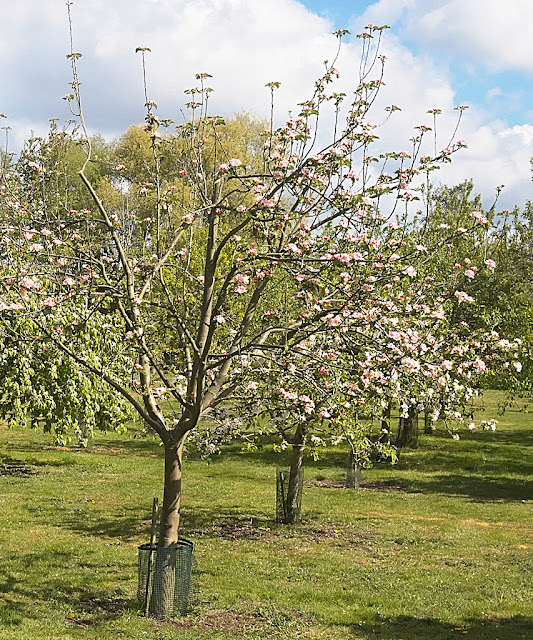 |
| Apple Blossom - 23 April 2017 White petals with pink tinge and underside |
This has been a good year for blossom and the orchard has been the prettiest I have seen it. To my eye, the apple blossom was plentiful and stood out from the background. The camera saw things somewhat differently: the blossom was there, but was only one of a number of elements competing for my attention in the final picture.
 |
| Orchard - 25 April 2017 Apple blossom at its peak. The bare branches and the metal guards around the trunks seem far more prominent than I remember them |
This is not the first time in the course of this project that I have come up against this phenomenum whereby the visual weight of an item is completely reduced, even though the proportion it occupies in the final picture is probably greater than it was in the original scene. It underlines how the brain interprets a picture completely differently from the way it interprets the image formed on the retina by the original landscape.
 | |
| Path by Wetlands - 16 April 2017 Apple tree growing by the path which seemed far more obvious than it does in this image. |
Folklore
 |
| Buds - 9 April 2017 The buds on this tree were a very deep pink, almost red |
Over the ages, the apple has featured prominantly in myths and legends, which is hardly surprising given that there is evidence that man has been eating apples for over 7000 years. Here, I want to highlight some of the folklore that is specifically associated with apple blossom.
 |
| Blossom - 23 April 2017 Its not difficult to see why apple blossom should symbolize a woman's beauty |
In China, apple blossom symbolises a woman's beauty. In other cultures, the flowers are associated with love, and have been included in love sachets and candles to attract love. In Wales, apple blossom was laid in coffins to restore youth in the afterlife.
 |
| Apple Blossom - 23 April 2017 Catch a falling petal to bring you luck Catch twelve for a year of good fortune |
I finish with a bit of English weather lore:
If apples bloom in March
In vain for them you'll search;
If apples bloom in April
Why then, they'll be plentiful;
If apples bloom in May
You can eat them night and day.
From that, it appears that 2017 should be a good year for apples!
Further Reading
Fresh Fruit Facts and FolkloreApple History, Folklore, Myth and Magic
Tree Lore: Apple
Apple Folklore
The Magic of the Ogham Trees: Apple - Quert
Fruit in Mythology
Next : The Wisdom of Dandelions







